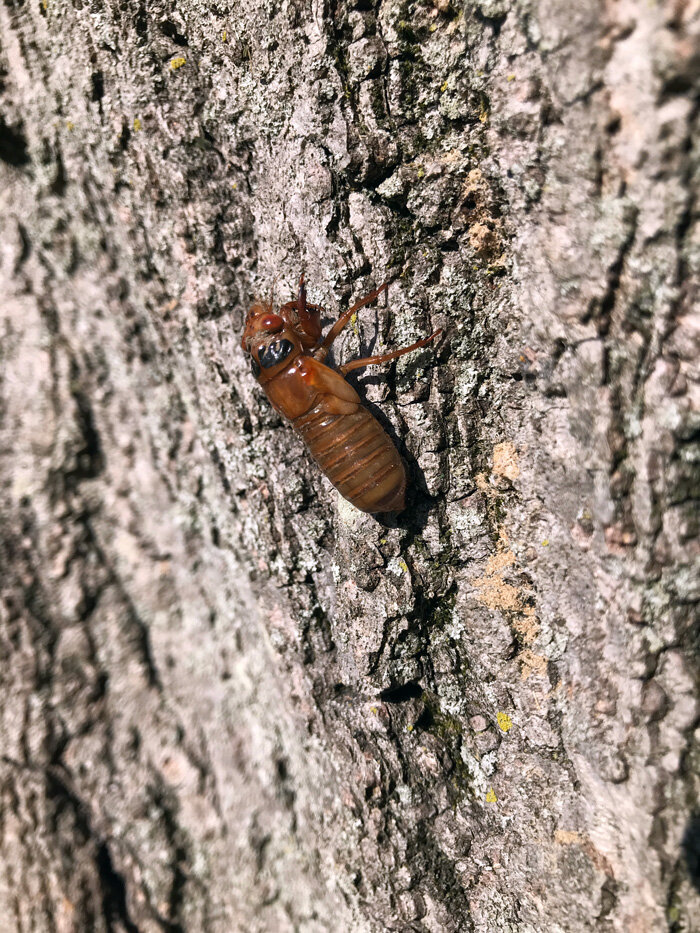If we had a baguette we would of made garlic bread to "fare la scarpetta con le vongole" (mop up the clam juices w/ the bottom of your shoe) but apparently everyone's hoarding baguettes (which at least makes more sense then guns + TP) so instead we just took regular sliced (whole grain sourdough) bread + smeared crushed garlic + olive oil (butter is also out of stock, so we're rationing the little that we have) + put it in the oven. Then put the water on to boil.
In another pot (a janky non-teflon 1 cuz it might get scratched up by the clams) put some chopped garlic, olive oil + white wine... we like to put sum sorta cherry tomatoes (ideally those nippled piennoli from the slopes of Mt Vesuvius) but alas, out of stock, so instead we chopped up some red peppers (sweet minis). At the same time u put the pasta in (linguini or spaghetti for vongole... nothing else will do) put the poor little clams in the pot w/ the lid on. Make sure to under-cook pasta, we just drain against the side of the sink to not have to wash a strainer then add lots of fresh chopped parsley, red pepper flakes, ground pepper, salt + a squeeze of lemon, then dump the clams (cook long enough for them to all open) + juices on top + hold onto the pot u used to steam the clams cuz u can use that for the discarded shells. We didn't take a photo of the vongole cuz we didn't know then we'd write this post + we're more into eating our food then taking pictures of it. We also had a salad (use them greens while their fresh) w/ avocado + red onion. We've been trying not to drink during the week, but hard to have vongole senza vino bianco.
April 2: Gnocchi Pesto—fresh basil should also be made into pesto as soon as possible... it doesn't mean u have to eat it that day, but at least make it. As we mentioned, we also made the salsa + jerk sauce at the same time to save on cleaning. Often humus gets worked into this routine, but not this time. Pesto is e-z p-z.. throw basil, pine nuts, garlic, olive oil + pecorino romano in the food processor + voilà. Most recipes probly call for parmigiano but our time in Rome has biased our buds. Sometimes we squeeze a squirt of lemon into the mix. ½ of the pesto we'll put in a jar (top off w/ a layer of olive oil so it stays green + unoxidized).
We chose gnocchi cuz we had pasta the night before + also cuz the last time we went to Trader Giotto's they were out of all the pastas except gnocchi. While the gnocchi were boiling (if u have gnocchi w/ tomato sauce u can cook them right in the sauce + save a pot) we sautéed a bit of shrimp + mustard greens (often we'll throw chick peas in for protein, but the shrimp suffice this time) then add the gnocchi + mix in the pesto last, after the heat is off. Again, w/ a salad + unfortunately sliced bread instead of a baguette to mop up the oily remnants. Pesto is hard to eat w/o vino rosso, but we can't drink red wine this time of year w/ our allergies + we ain't sposed to be drinking anyway during the week. We usually also have sparkling water but SodaStream is taking forever refilling our cannisters... so it's tap water straight up, w/ a squeeze of lemon (April is the month they chlorinate the water in DC (gotta keep them pipes clean living in the swamp) which smells gross but u can't really taste it). Again, we didn't take photos of the final product, tho here's the pesto sauce we haven't used yet, along w/ the salsa we haven't tapped into either.
April 3: Jerk Chicken—we haven't been talking much about what we eat the rest of the day.... if we have leftovers from the night before we skip breakfast + eat those for lunch. Or we eat a late breakfast + skip lunch, or just snack on whatever throughout the day. Lately we've been into smoothies + while we haven't resorted yet to frozen berries, we got some for the day when we can't get 'em fresh.
'Jerk' is 1 of those vague words that to us means whatever u find laying around, but usually entails roasted habaneros (which we already mentioned we have a frozen stash of) + green onions... those are the only 2 real requirements, + oh, spose allspice is must-have to be jerk. If we have pickles on hand (which we do) we'll pour some of the briney water into the mix, or capers w/ some of the juices they're soaking in,... soy sauce, ponzu, whatever salad dressing u might have, lime, vinegar, salt, pepper, spices, etc. Baste the chicken in this concoction overnight (we did all this the day before). Then all u got to do is fire up the grill + throw 'em on.
Actually, shuck the corn + put those on 1st cuz they take longer. Then put the meatier breasts + legs before the wings + smaller pieces... tho we couldn't get a whole chicken, all we could get was 2 legs + a package of wings (if we wanted organic, free range). We don't do chicken that often btw, maybe once a month. It's the only animal we eat that doesn't live in the ocean. We justify it cuz it's low on the food chain + comparatively resource-efficient, but fact is it's delicious. Roasted corn doesn't need anything, perhaps just a squeeze of lime. And again, a salad, while the greens last. Washed down w/ Pilsner Urquel. We got tired of waiting for SodaStream so canceled our order + put on a bandanna + braved the hardware store to exchange our cannisters. After dinner mixed sum gin into our limey soda water (it was Friday night after all)... nursing our Japanese gin to stretch it for as long as we can.
April 4: Tacos—we've eaten tacos probably more than any other dish in our lifetime, at least once if not twice a week. We had a bit of leftover chicken so grilled it up w/ sum mushrooms, green onions + a few types of peppers (dare we use the word fajitas?). We actually scored some tortillas (albeit small "street" style ones) otherwise we would of made our own. And whipped up a batch of guacamole... + the salsa, sour cream, jack cheese (sadly they were out jalapeño jack) + a bottle of pilsner.
April 5: Risotto—take the bones you've been collecting from the chicken, along w/ whatever else (we keep a pot in our fridge for scraps), the tips of onions, celery, etc. + add water to boil. The longer they simmer the better. This week we made risotto w/ the broth, but the last time we made vegetable bean soup + the time before that pozole.
While the broth simmers start chopping up stuff for the risotto... this time we put garlic, eggplant, shitake mushrooms, a few frozen shrimps, mustard greens (add last) + green chilies. Fortunately we have 10 kg of frozen roasted Hatch chilies we got last September... we still have about 5 kg left. Roast the garlic + briefly toast the risotto then start adding stuff. We just put the strainer right on top + pour the broth straight in. Set the risotto simmering, stirring often. Once the stuff in the strainer has cooled (spraying a bit of cold water thru helps) we like to get in there + wring all those juices out, squeezing the remnants to a pulp. Broth-making should correspond w/ the day before garbage day so these remnants don't stink up your kitchen or attract vermin. When it's near to done grate some pecorino in. We served it on a bed of arugula since we had some to use up.
April 6: black bean tostadas/tacos—we had a few leftover broken tortillas that we put in the oven to make tostadas + since we don't have any more tortillas we made our own from Maseca... again, plenty used to doing this since they don't have tortillas in Rome or Nairobi (not corn ones anyway). We still have salsa from a few days ago + grated some cheese + diced up some peppers, green onions, arugula, cilantro, sour cream, etc...
April 7: Penne Pesto w/ shrimp, mushrooms, peppers on a bed of arugula (using rest of pesto sauce made a few days ago).
April 8: Veggie-burgers /w fries + babaga-humus—scraping the bottom of the fridge so dipped into the freezer to dig out some Engine-2 Pinto-Habanero Burgers that we've been meaning to try since we like their cereals so much (all simple plant-based ingredients w/ no added oils or sugars). Grilled up some onions, mushrooms + peppers to put on the patties + also a slice of NY sharp cheddar cheese. Roasted some potatoes in the oven (w/paprika, rosemary, garlic, salt + o'bay). While we had the oven on, roasted an eggplant + mixed it w/ some humus (why not... humus + babaganoush have basically the same ingredients): chick peas, tahini, olive oil, lemon, fresh parsley, habanero paste, sesame seeds + the roasted eggplant). Celery + pickles. Washed down w/ a bottle of Cava since our bedder-½ got promoted to full professor (she was already tenured + endowed, but technically "assistant" prof before) so we were celebrating. The verdict on Engine-2 Pinto-Habanero "burgers"? Consistency was weird, soft + mushy + falling apart, but w/ all the fixings + mayo + mustard it's all tasty.

























